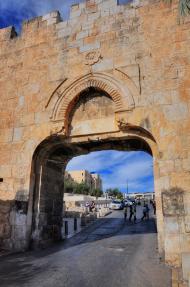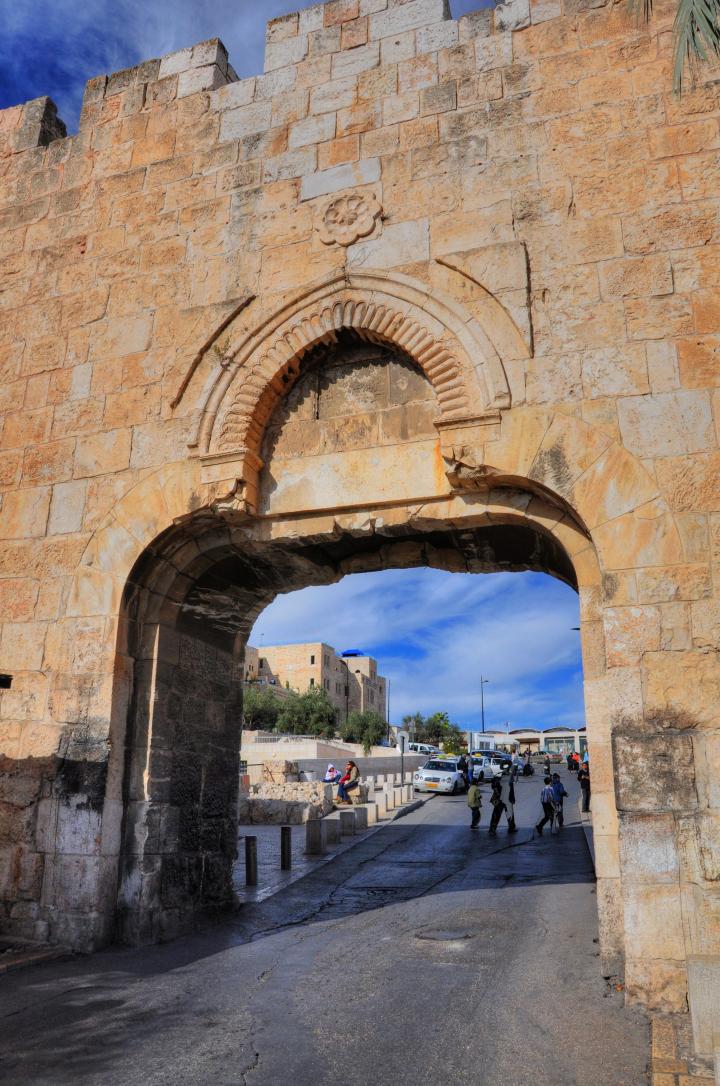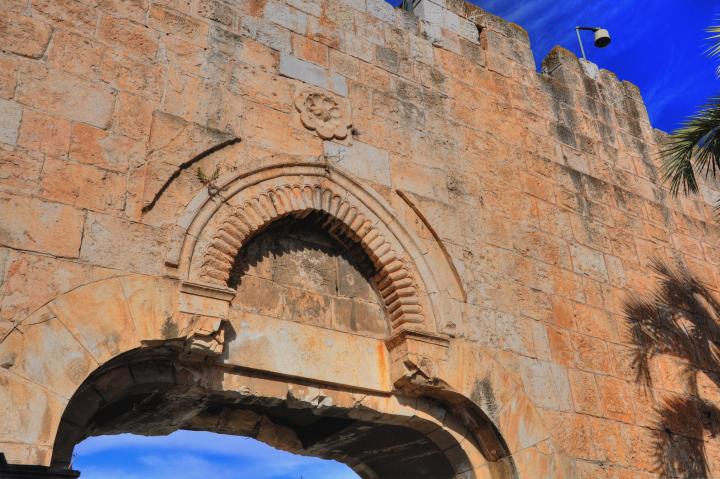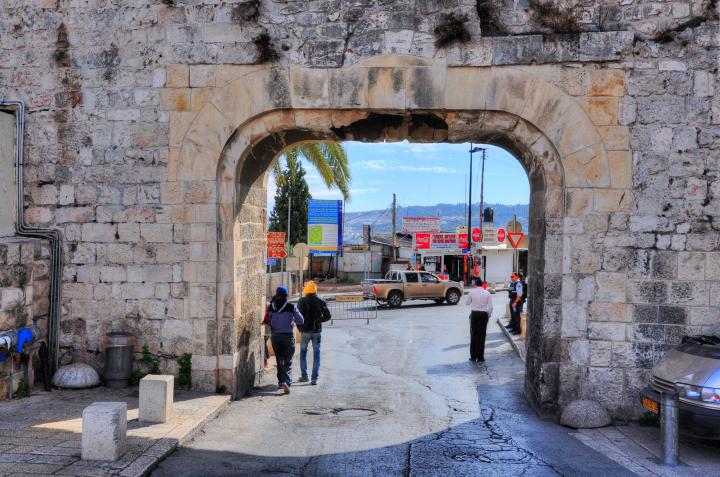The Ottoman period gate is located on the south side, and named after the Biblical gate that was located nearby.
Home > Sites > Jerusalem > Dung (Ashpoth) Gate
Contents:
Overview
Location
History
Photos
* Outside
* Inside
Biblical
Etymology
Links
Overview:
The Dung Gate gets its name from the fact that it was historically used to remove garbage and waste from the city. In biblical times, the gate was known as the “Potter’s Gate” because it led to the potter’s quarter of the city. The Dung gate was located during the times of the first and second temples somewhere on the south side of the city, closer to the Kidron valley.
The current gate dates back to the 16th century, when the Ottoman Sultan Suleiman the Magnificent ordered the walls of the Old City to be rebuilt. It is one of the eight gates in the walls surrounding the Old City of Jerusalem. It is located on the south side of the city, facing the Hinnom Valley, also known as the Valley of Gehenna.
Today, the Dung Gate is an important entrance to the Old City, providing access to the Western Wall and the Jewish Quarter. Visitors can explore the gate and its surroundings, including the archaeological site of the Ophel, which contains ancient ruins dating back to the First Temple period. The area around the Dung Gate is also known for its vibrant street markets, selling a variety of goods including textiles, ceramics, and souvenirs.
The present gate, constructed by the Ottomans, is located near the southern wall, and is the main entrance to the western (wailing) wall.
Location:
The aerial map shows the 8 gates of Jerusalem, with the Golden gate on the south side. These are the gates, listed clockwise starting from the west corner:
1. New gate
2. Damascus gate (on the north-western side)
3. Herod’s gate (on the north side)
4. Lions’ gate (near St. Anna)
5. Golden gate (a closed gate)
6. Dung gate (This site; near the western wall)
7. Zion gate (on the south-west side)
8. Jaffa gate (tower of David)
You can point on the purple points to navigate to the selected site; the white points will be featured in the future.
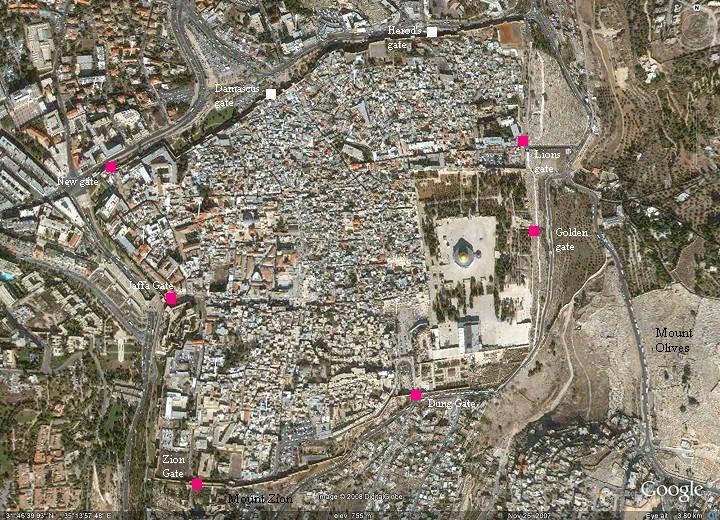
History of the place:
- First temple
During the Biblical period, the gate was located to the south-east of the existing gate, located on the walls of the City of David – closer to the Kidron valley, adjacent to the Shiloah pool. The garbage and ash from the temple was removed through this gate, earning it the name “gate of the garbage” (Sha’ar Ashpoth).
The gate is described in Nehemiah’s accounts on his survey of the ruined walls after relocating from the Persian court to Jerusalem (about 445 BC). At this time the exiles returned from Babylonian (538 BC to 445 BC), but the condition of the city was yet in a bad shape.
The Dung gate was broken and burnt, as described in his accounts of the secret night review of the walls (Nehemiah 2 :12-17):
” And I arose in the night, I and some few men with me; neither told I any man what my God had put in my heart to do at Jerusalem: neither was there any beast with me, save the beast that I rode upon. And I went out by night by the gate of the valley, even before the dragon well, and to the dung port, and viewed the walls of Jerusalem, which were broken down, and the gates thereof were consumed with fire….
Then said I unto them, Ye see the distress that we are in, how Jerusalem lieth waste, and the gates thereof are burned with fire: come, and let us build up the wall of Jerusalem, that we be no more a reproach.”.
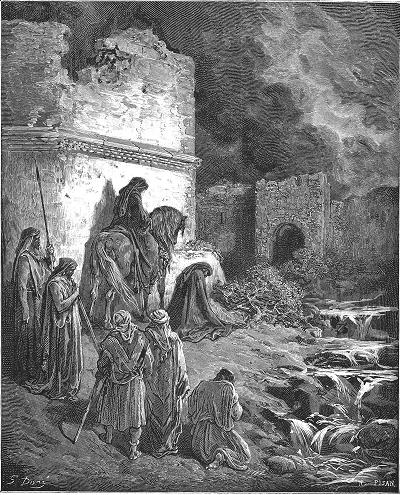
Nehemiah views the ruined walls – by Gustav Dore (French artist, 1832-1883)
- Second temple (Persian period)
Nehemiah receives a permission from his master, King of Persia, to rebuild the walls of Jerusalem. His workers rebuild the gate (Nehemiah 3 :14): “”But the dung gate repaired Malchiah the son of Rechab, the ruler of part of Bethhaccerem; he built it, and set up the doors thereof, the locks thereof, and the bars thereof”.
- Ottomans
The present gate was built during the construction of the walls by Suleiman “the Magnificent” (1538). It was a narrow gate and allowed only access by foot. The gate was used by the villagers from nearby Silwan.
-
Modern times
In 1948, following Israel’s independence war, the Jordanians controlled the old city. They widened the gate in order to allow vehicle passage.
During the 6 day war (1967) the old city was reclaimed by Israel, and the Israeli forces used this gate as one of the entry points. The gate then became the main entry to the Western (Wailing) wall and the Jewish quarter.
Photos:
Outside:
The external side of the gate is shown below. The gate is dated to 1948 when the Jordanians opened up the narrow entry in order to allow vehicles to drive into the old city from its south side.
Click on the photo to view it in higher resolution…
Another view of the external side. Past the gate is the entrance to the southern wall archaeological park (entry on the left side) and further on the Western wall and the Mugrabim gate, one of the entrances to the temple mount.
Inside:
The following photo shows the inner side of the gate.
Biblical References:
Nehemiah 2, 13
Nehemiah tells about the grave situation of the walls after the Jews return to Jerusalem from the Babylonian exile, finding the city in ruins:
“And I went out by night by the gate of the valley, even before the dragon well, and to the dung port, and viewed the walls of Jerusalem, which were broken down, and the gates thereof were consumed with fire”.
Nehemiah 3, 14
Nehemiah reports on the repairs to the walls around the city:
“But the dung gate repaired Malchiah the son of Rechab, the ruler of part of Bethhaccerem; he built it, and set up the doors thereof, the locks thereof, and the bars thereof”.
Etymology (behind the name):
* Names of the gate:
- Sha’ar – Hebrew: Gate
- Ashpoth – Hebrew for garbage. This name was “earned” from the use of the valley west of the temple mount to dispense the garbage and the ash from the temple.
- Dung – Manure or garbage, translated from the word “Ashpoth”.
- Westerners, Mugrabim – since the North-Africans quarters were located on this section of the city before 1967, the gate was named after them. Another gate into the temple mount also shared the same name.
- Tanners (Bursakaim) – During the Crusaders period, the valley west of the temple mount was used for the leather industry, so the gate was named after this profession.
Links:
* Other:
- Biblical pictures by Gustave Doré (1832-1883) – public domain
BibleWalks.com – walk with us through the sites of the Holy Land
Golden Gate <—previous Jerusalem site–<<< All Sites >>>—next Jerusalem site–> Lions Gate
This page was last updated on Feb 20, 2023 (add overview)
Sponsored links:
